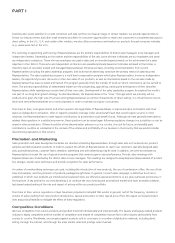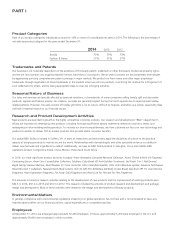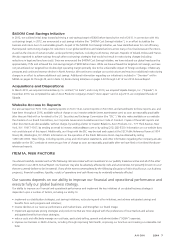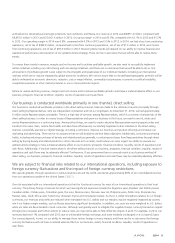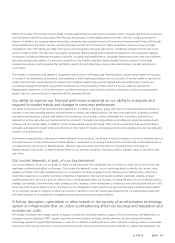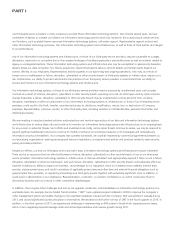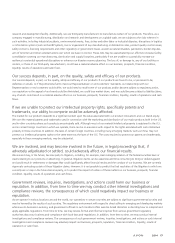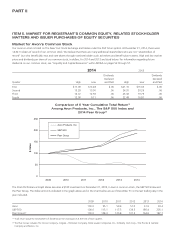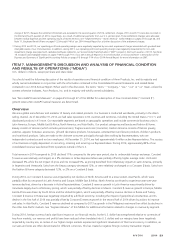Avon 2014 Annual Report Download - page 22
Download and view the complete annual report
Please find page 22 of the 2014 Avon annual report below. You can navigate through the pages in the report by either clicking on the pages listed below, or by using the keyword search tool below to find specific information within the annual report.PART I
use third-party service providers in many instances to provide these information technology systems. Over the last several years, we have
undertaken initiatives to increase our reliance on information technology systems which has resulted in the outsourcing of certain services
and functions, such as global human resources information technology systems, call center support, Representative support services and
other information technology processes. Our information technology systems and infrastructure, as well as those of third parties, are integral
to our performance.
Any of our information technology systems and infrastructure, or those of our third-party service providers, may be susceptible to outages,
disruptions, destruction or corruption due to the complex landscape of localized applications and architectures as well as incidents related to
legacy or unintegrated systems. These information technology systems and infrastructure also may be susceptible to cybersecurity breaches,
attacks, break-ins, data corruption, fire, floods, power loss, telecommunications failures, terrorist attacks and similar events beyond our
control. We rely on our employees, Representatives and third parties in our day-to-day and ongoing operations, who may, as a result of
human error or malfeasance or failure, disruption, cyberattack or other security breach of third party systems or infrastructure, expose us to
risk. Furthermore, our ability to protect and monitor the practices of our third-party service providers is more limited than our ability to
protect and monitor our own information technology systems and infrastructure.
Our information technology systems, or those of our third-party service providers may be accessed by unauthorized users such as cyber
criminals as a result of a failure, disruption, cyberattack or other security breach, exposing us to risk. As techniques used by cyber criminals
change frequently, a failure, disruption, cyberattack or other security breach may go undetected for a long period of time. A failure,
disruption, cyberattack or other security breach of our information technology systems or infrastructure, or those of our third-party service
providers, could result in the theft, transfer, unauthorized access to, disclosure, modification, misuse, loss, or destruction of Company,
employee, Representative, customer, vendor, or other third-party data, including sensitive or confidential data, personal information and
intellectual property.
We are investing in industry standard solutions and protections and monitoring practices of our data and information technology systems
and infrastructure to reduce these risks and continue to monitor our information technology systems and infrastructure on an ongoing basis
for any current or potential threats. Such efforts and investments are costly, and as cyber threats continue to evolve, we may be required to
expend significant additional resources to continue to modify or enhance our protective measures or to investigate and remediate any
information security vulnerabilities. As a company that operates worldwide, we could be impacted by commercial agreements between us
and processing organizations, existing and proposed laws and regulations, and government policies and practices related to cybersecurity,
privacy and data protection.
Despite our efforts, our and our third-party service providers’ data, information technology systems and infrastructure may be vulnerable.
There can be no assurance that our efforts will prevent a failure, disruption, cyberattack or other security breach of our or our third-party
service providers’ information technology systems or infrastructure, or that we will detect and appropriately respond if there is such a failure,
disruption, cyberattack or other security breach. Any such failure, disruption, cyberattack or other security breach could adversely affect our
business including our ability to expand our business, cause damage to our reputation, result in increased costs to address internal data,
security, and personnel issues, and result in violations of applicable privacy laws and other laws and external financial obligations such as
governmental fines, penalties, or regulatory proceedings and third-party private litigation with potentially significant costs. In addition, it
could result in deterioration in our employees’, Representatives’, customers’, or vendors’ confidence in us, which could cause them to
discontinue business with us or result in other competitive disadvantages.
In addition, there may be other challenges and risks as we upgrade, modernize, and standardize our information technology systems on a
worldwide basis. For example, Service Model Transformation (“SMT”) was a global program initiated in 2009 to improve the Company’s
order management system and enable changes to the way Representatives interact with the Company. SMT was piloted in Canada during
2013, and caused significant business disruption in that market. We decided to halt further roll-out of SMT in the fourth quarter of 2013. In
addition, in the third quarter of 2011, we experienced challenges in implementing an ERP system in Brazil which impacted service levels,
which in turn negatively impacted average order and Active Representative and revenue growth during 2011.


